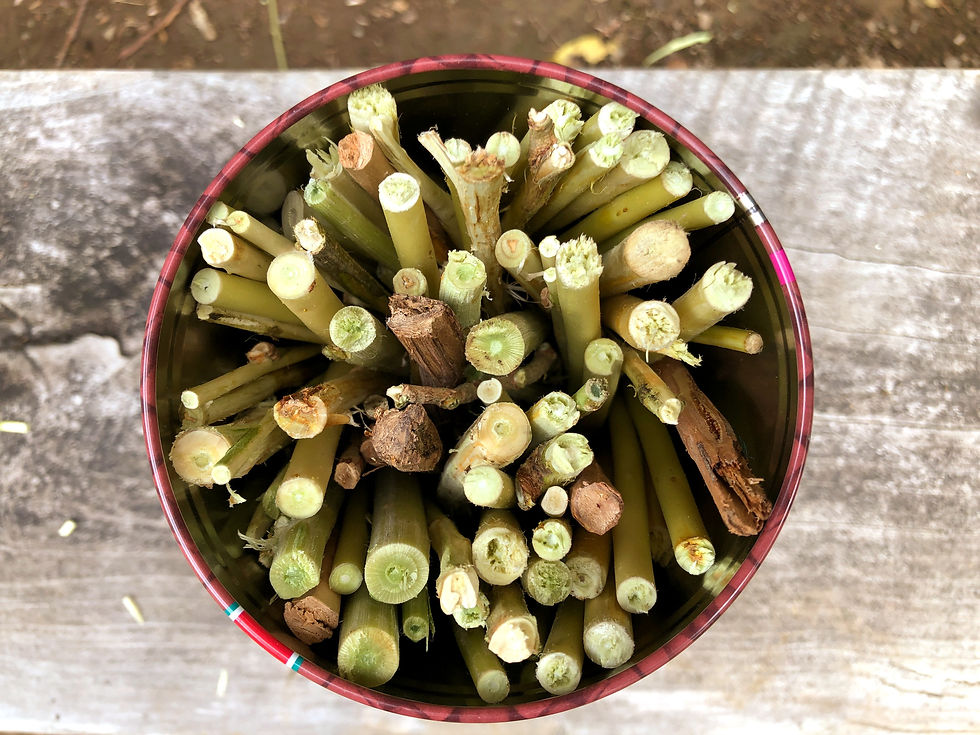Making Charcoal the Early Human Way
- Carol Palmer

- Mar 11, 2020
- 3 min read
Last week we took our three 9-12 classes on our annual Fundamental Human Needs Camp and it was EPIC! As our school year begins at the end of January, we spend the best part of the previous year preparing for camp, so it is a huge deal when it finally comes around.
You can read about how we do camp here and here, but the basic concept is that we try to meet all of our Fundamental Human Needs for ourselves. This includes building shelters to sleep in, making food from as close to the original source as possible (catching fish, grinding wheat, collecting honey from hives etc.), making our own transport (rafts), tools (knives, lemon squeezers, rolling pins, bows and arrows), medicines (balms from locally harvested herbs), and of course meeting the need for culture through art, craft and song.
It’s hard to pick my favourite activity this year as there were so many awesome ones (check out the Montessori Handwork feed on Facebook or Instagram for pictures) but today I am excited to tell you about our artistic experiment that turned out to be a truly beautiful discovery for all.
I have had it in my mind for a while that I would like to make our own charcoal. Not just the lumps of singed wood that you are left with after a bonfire, but high quality artist’s drawing sticks. Camp was, of course the place to try it, so one slightly cloudy afternoon, I gathered a group of interested children and explained my plan. They were all eager to help so we went up to the fire circle and spent an amiable hour or so stripping the bark off several different types of young, thin branches.

Note: we used small, sharp penknives to strip the bark, if you plan to try this, please see my knife safety rules here.
Once all the sticks were stripped, we cut them all to the perfect length to fit into a tin with a tightly fitting lid.

Meanwhile, several other children were working on one of the most fundamental of all human needs – fire-making.

The idea was that we would put the tin in the fire and the sticks would give off their moisture and gasses but in the absence of oxygen would not be able to combust, thus creating charcoal.
Just as the tin was full and we were ready to put it in the fire, Eric, our wood-turning expert, appeared to see what we were up to. We told him the plan and he pointed out that the gasses in the tin would expand in the heat and pop the lid off. Oops! With everything we know about the elements following their laws, we should have thought of that!
We poked a hole in the lid and carefully placed the tin in the fire, before laying more wood over it so it would be encased in heat.


At first, all we could see was the paint singeing off the tin but then a small flame appeared at the hole we had poked in the lid. The gasses were burning off! (I might have made a little squeal of excitement at this point!)

We watched it burn until the flame on the lid disappeared and then rolled the tin out of the fire and left it to cool completely before the moment of truth.

We carried the tin carefully back to the main camp and with much anticipation, prised the now stubbornly attached lid open to find...

Beautiful charcoal sticks!
They were perfect!
A bit bent maybe, but perfect drawing consistency.

In a beautiful mixture of buzzing excitement and careful reverence, the children passed out pieces of our sooty treasure and in a flurry of charcoal and paper, sat and drew and drew and drew.

What better way to connect with our early human ancestry than to make art with one of the earliest drawing mediums known to man? I found it fascinating how the charcoal led many of the children to revisit early drawing explorations. With this ‘new’ medium, they were much more interested in the process than the outcome – experimenting with mark-making rather than picture making. Scratching, smudging and layering – walking in the shoes of their ancestors to rediscover the process that so many had discovered before them.
Now that we have done it once, and know how easy and successful it is, I would definitely recommend trying it to anyone interested in drawing with charcoal. Wherever possible start by making your own tools, and of course, share your journey in the comments section of in the Montessori Handwork Threads Facebook group.









Comments